CHCECE022 Diploma: Assessment on Promoting Children’s Agency
VerifiedAdded on 2023/06/15
|74
|16736
|490
Homework Assignment
AI Summary
This document is a student's completed assessment pack for the CHCECE022 unit, focusing on promoting children's agency within an early childhood education setting. It includes a cover sheet with student and trainer details, an assessment plan outlining various tasks such as a knowledge test, case studies, project work, and work placement observations. The assessment conditions emphasize creating a learning environment that reflects children's interests, stimulates their development, and supports their participation. The document also covers academic integrity, plagiarism, collusion policies, and information on reasonable adjustments for students with special needs. Furthermore, it details the foundation skills essential to performance, relevant legislation, and the principles and rules of assessment. The pack includes a pre-assessment checklist to ensure students are prepared for the assessment tasks and highlights the importance of feedback in the learning process. Desklib offers a range of similar resources and solved assignments for students.
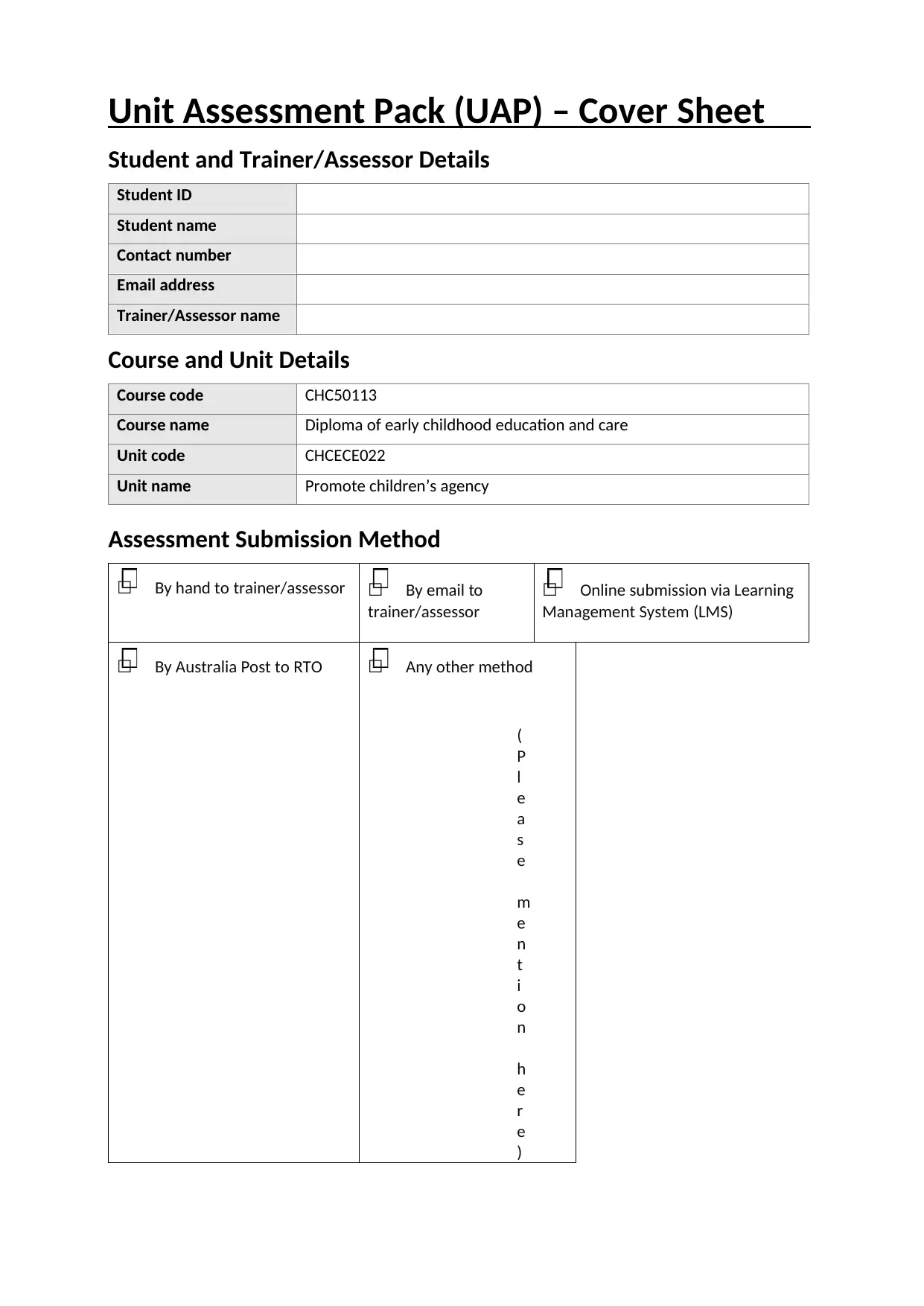
Unit Assessment Pack (UAP) – Cover Sheet
Student and Trainer/Assessor Details
Student ID
Student name
Contact number
Email address
Trainer/Assessor name
Course and Unit Details
Course code CHC50113
Course name Diploma of early childhood education and care
Unit code CHCECE022
Unit name Promote children’s agency
Assessment Submission Method
☐ By hand to trainer/assessor ☐ By email to
trainer/assessor
☐ Online submission via Learning
Management System (LMS)
☐ By Australia Post to RTO ☐ Any other method
(
P
l
e
a
s
e
m
e
n
t
i
o
n
h
e
r
e
)
Student and Trainer/Assessor Details
Student ID
Student name
Contact number
Email address
Trainer/Assessor name
Course and Unit Details
Course code CHC50113
Course name Diploma of early childhood education and care
Unit code CHCECE022
Unit name Promote children’s agency
Assessment Submission Method
☐ By hand to trainer/assessor ☐ By email to
trainer/assessor
☐ Online submission via Learning
Management System (LMS)
☐ By Australia Post to RTO ☐ Any other method
(
P
l
e
a
s
e
m
e
n
t
i
o
n
h
e
r
e
)
Paraphrase This Document
Need a fresh take? Get an instant paraphrase of this document with our AI Paraphraser

Student Declaration
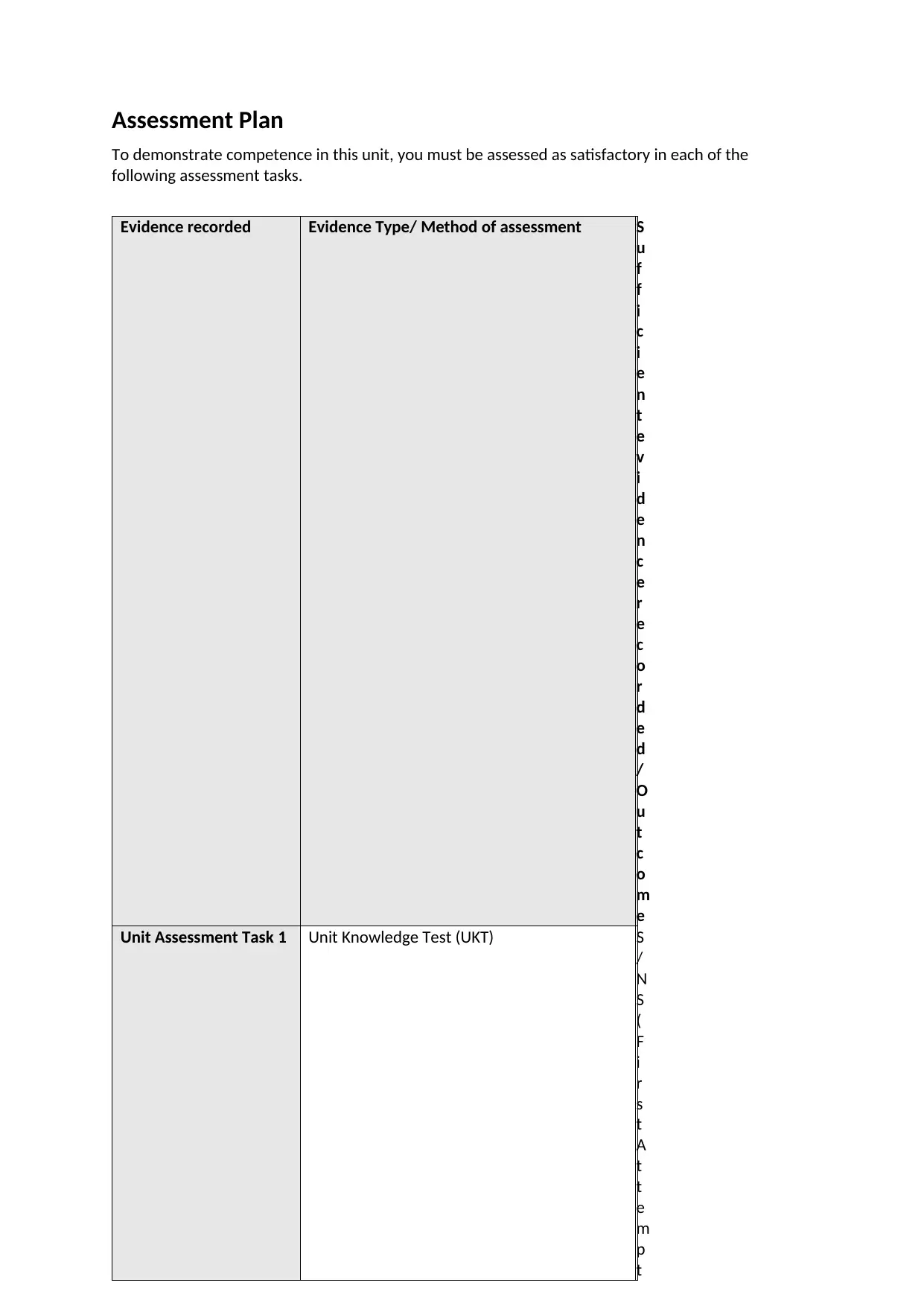
Assessment Plan
To demonstrate competence in this unit, you must be assessed as satisfactory in each of the
following assessment tasks.
Evidence recorded Evidence Type/ Method of assessment S
u
f
f
i
c
i
e
n
t
e
v
i
d
e
n
c
e
r
e
c
o
r
d
e
d
/
O
u
t
c
o
m
e
Unit Assessment Task 1 Unit Knowledge Test (UKT) S
/
N
S
(
F
i
r
s
t
A
t
t
e
m
p
t
To demonstrate competence in this unit, you must be assessed as satisfactory in each of the
following assessment tasks.
Evidence recorded Evidence Type/ Method of assessment S
u
f
f
i
c
i
e
n
t
e
v
i
d
e
n
c
e
r
e
c
o
r
d
e
d
/
O
u
t
c
o
m
e
Unit Assessment Task 1 Unit Knowledge Test (UKT) S
/
N
S
(
F
i
r
s
t
A
t
t
e
m
p
t
⊘ This is a preview!⊘
Do you want full access?
Subscribe today to unlock all pages.

Trusted by 1+ million students worldwide
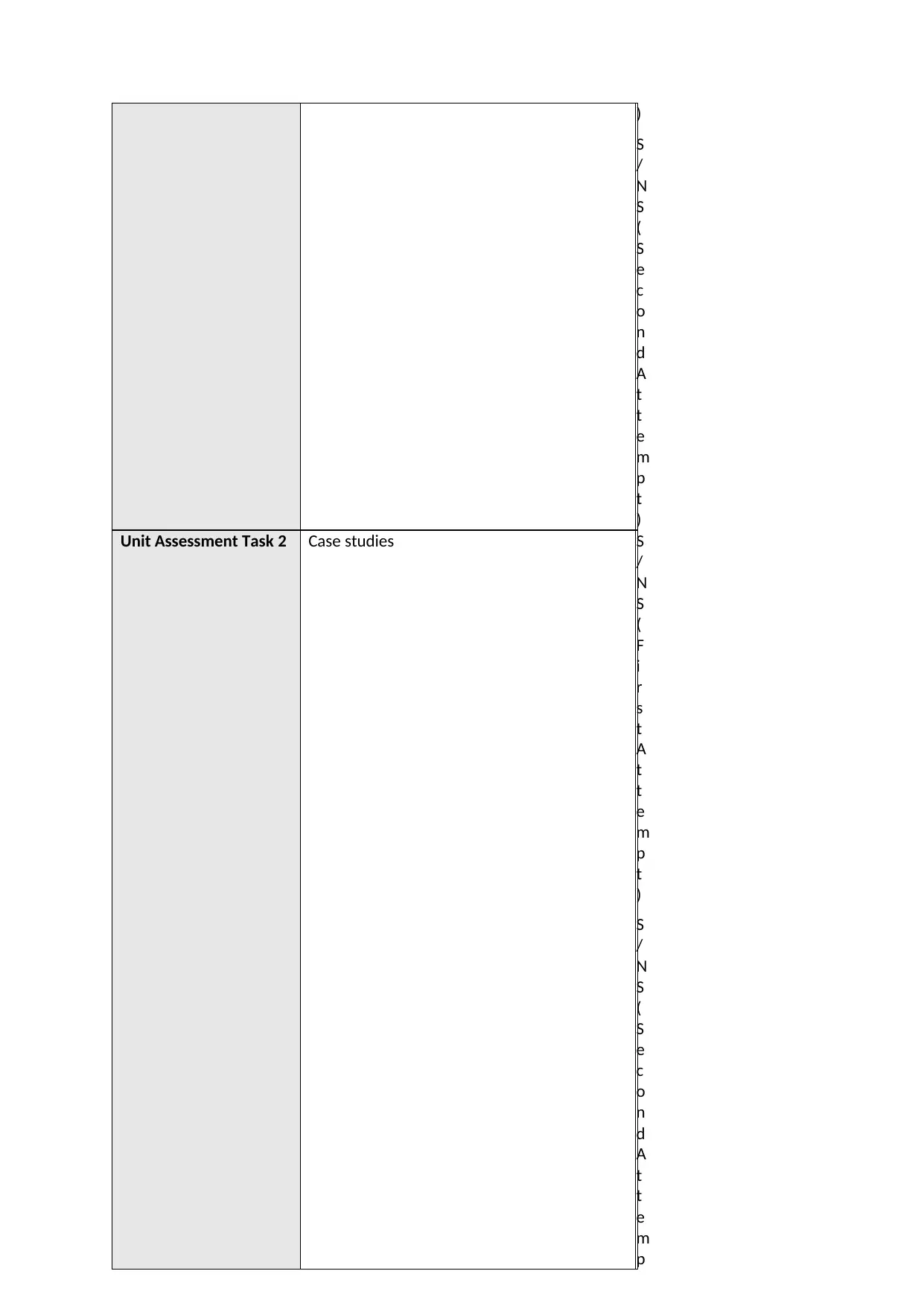
)
S
/
N
S
(
S
e
c
o
n
d
A
t
t
e
m
p
t
)
Unit Assessment Task 2 Case studies S
/
N
S
(
F
i
r
s
t
A
t
t
e
m
p
t
)
S
/
N
S
(
S
e
c
o
n
d
A
t
t
e
m
p
S
/
N
S
(
S
e
c
o
n
d
A
t
t
e
m
p
t
)
Unit Assessment Task 2 Case studies S
/
N
S
(
F
i
r
s
t
A
t
t
e
m
p
t
)
S
/
N
S
(
S
e
c
o
n
d
A
t
t
e
m
p
Paraphrase This Document
Need a fresh take? Get an instant paraphrase of this document with our AI Paraphraser

t
)
Unit Assessment Task 3 Unit Project S
/
N
S
(
F
i
r
s
t
A
t
t
e
m
p
t
)
S
/
N
S
(
S
e
c
o
n
d
A
t
t
e
m
p
t
)
Unit Assessment Task 4 Work placement task S
/
N
S
(
F
i
r
s
t
A
t
)
Unit Assessment Task 3 Unit Project S
/
N
S
(
F
i
r
s
t
A
t
t
e
m
p
t
)
S
/
N
S
(
S
e
c
o
n
d
A
t
t
e
m
p
t
)
Unit Assessment Task 4 Work placement task S
/
N
S
(
F
i
r
s
t
A
t
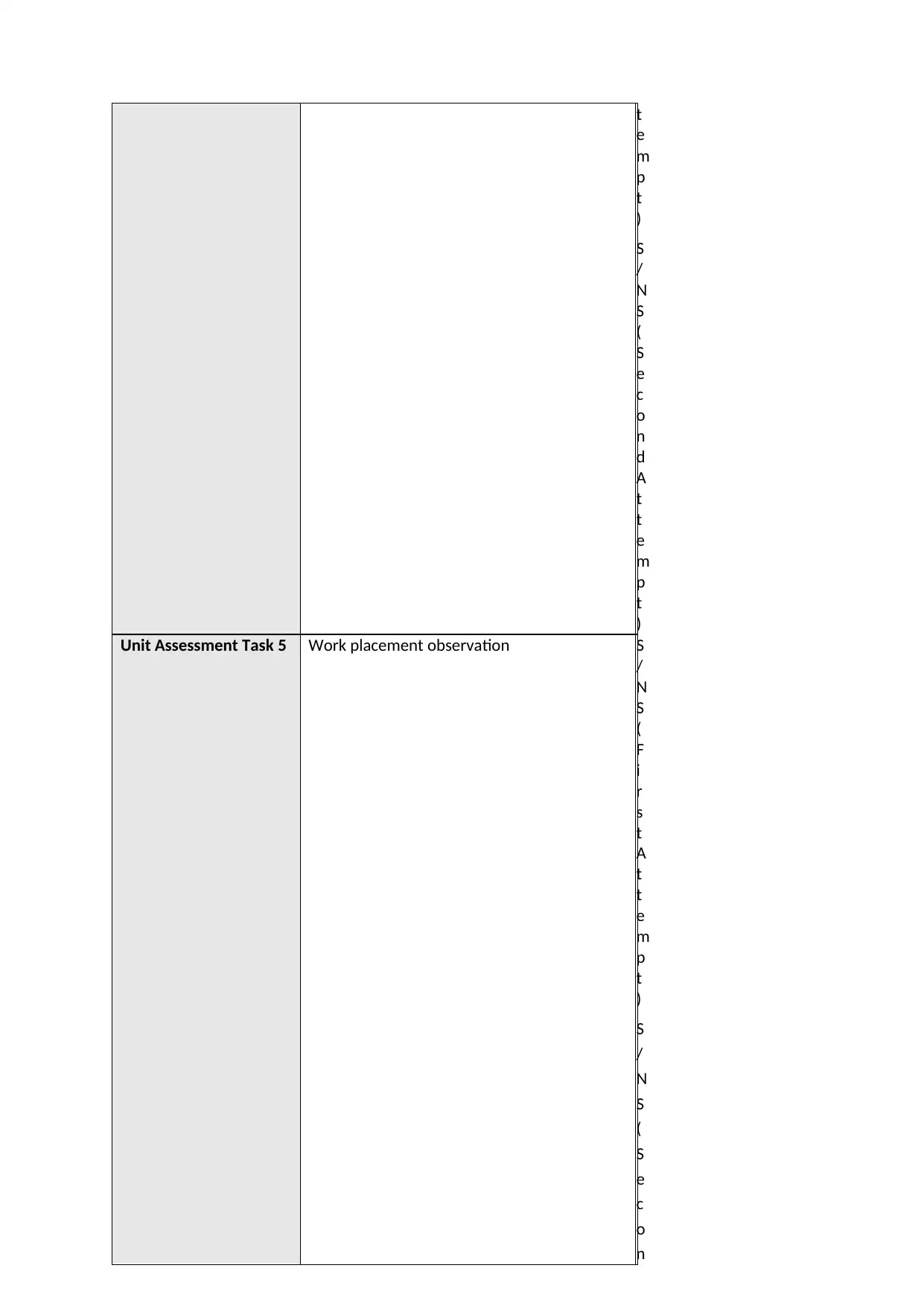
t
e
m
p
t
)
S
/
N
S
(
S
e
c
o
n
d
A
t
t
e
m
p
t
)
Unit Assessment Task 5 Work placement observation S
/
N
S
(
F
i
r
s
t
A
t
t
e
m
p
t
)
S
/
N
S
(
S
e
c
o
n
e
m
p
t
)
S
/
N
S
(
S
e
c
o
n
d
A
t
t
e
m
p
t
)
Unit Assessment Task 5 Work placement observation S
/
N
S
(
F
i
r
s
t
A
t
t
e
m
p
t
)
S
/
N
S
(
S
e
c
o
n
⊘ This is a preview!⊘
Do you want full access?
Subscribe today to unlock all pages.

Trusted by 1+ million students worldwide

d
A
t
t
e
m
p
t
)
Result C/NYC Date assessed
Trainer/Assessor
Signature
A
t
t
e
m
p
t
)
Result C/NYC Date assessed
Trainer/Assessor
Signature
Paraphrase This Document
Need a fresh take? Get an instant paraphrase of this document with our AI Paraphraser

Assessment Conditions
This unit describes the skills and knowledge required to promote and encourage children’s agency.
This unit applies to educators working in a range of education and care services.
The skills in this unit must be applied in accordance with Commonwealth and State/Territory
legislation, Australian/New Zealand standards and industry codes of practice.
Establish a learning environment that reflects children’s interests
Provide opportunities that stimulate learning and development
Design, implement and evaluate learning experiences for children
Support children to participate
The student will have access to the following:
Learner guide
PowerPoint presentation
Unit Assessment Pack (UAP)
Access to other learning materials such as textbooks
The resources required for these assessment tasks also include:
Access to a computer, the Internet and word-processing system such as MS Word
Your trainer/assessor will confirm assessment submission details for each assessment task.
Academic Integrity:
Academic Integrity is about the honest presentation of your academic work. It means acknowledging
the work of others while developing your own insights, knowledge and ideas.
As a student, you are required to:
Undertake studies and research responsibly and with honesty and integrity
Ensure that academic work is in no way falsified
This unit describes the skills and knowledge required to promote and encourage children’s agency.
This unit applies to educators working in a range of education and care services.
The skills in this unit must be applied in accordance with Commonwealth and State/Territory
legislation, Australian/New Zealand standards and industry codes of practice.
Establish a learning environment that reflects children’s interests
Provide opportunities that stimulate learning and development
Design, implement and evaluate learning experiences for children
Support children to participate
The student will have access to the following:
Learner guide
PowerPoint presentation
Unit Assessment Pack (UAP)
Access to other learning materials such as textbooks
The resources required for these assessment tasks also include:
Access to a computer, the Internet and word-processing system such as MS Word
Your trainer/assessor will confirm assessment submission details for each assessment task.
Academic Integrity:
Academic Integrity is about the honest presentation of your academic work. It means acknowledging
the work of others while developing your own insights, knowledge and ideas.
As a student, you are required to:
Undertake studies and research responsibly and with honesty and integrity
Ensure that academic work is in no way falsified
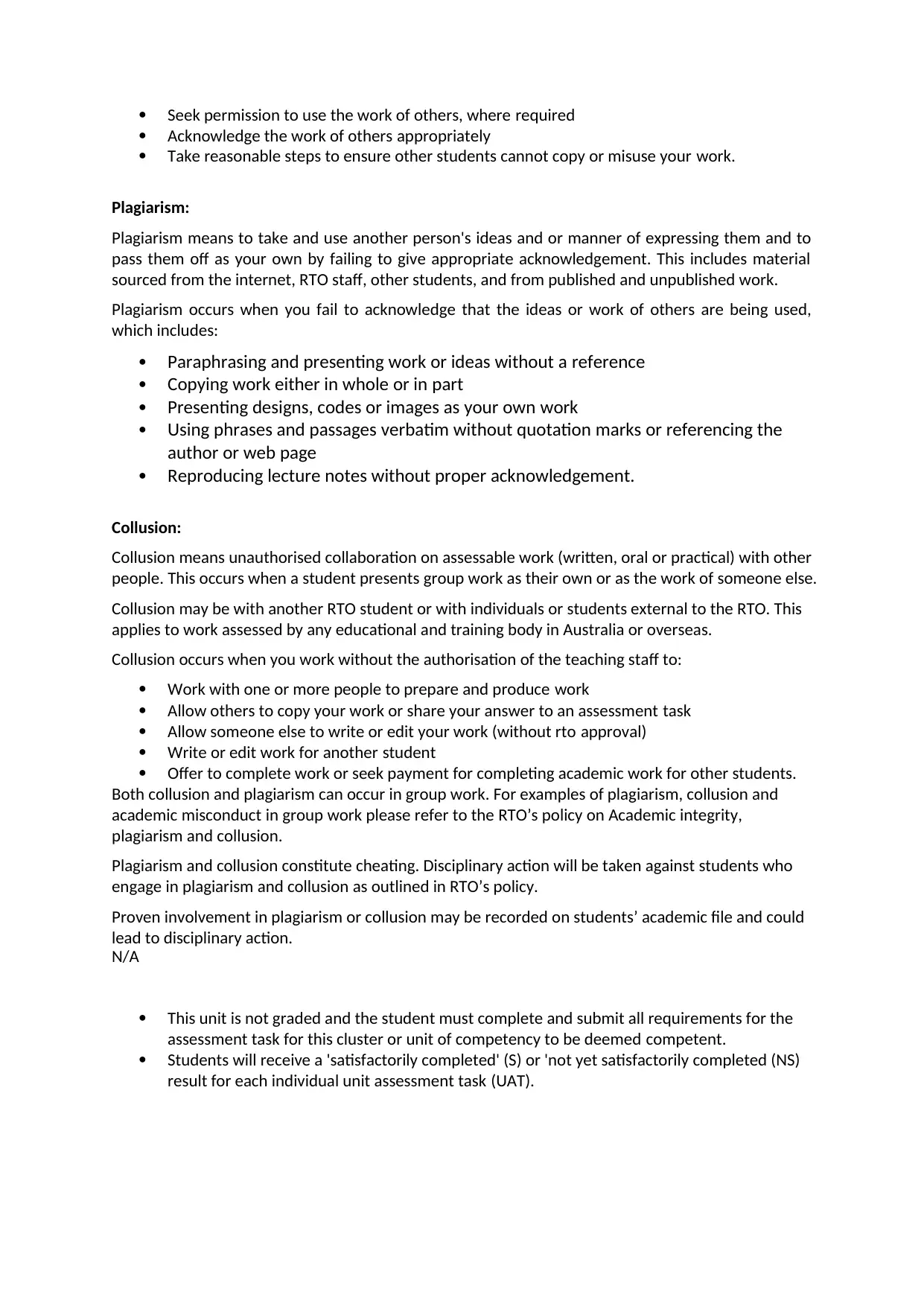
Seek permission to use the work of others, where required
Acknowledge the work of others appropriately
Take reasonable steps to ensure other students cannot copy or misuse your work.
Plagiarism:
Plagiarism means to take and use another person's ideas and or manner of expressing them and to
pass them off as your own by failing to give appropriate acknowledgement. This includes material
sourced from the internet, RTO staff, other students, and from published and unpublished work.
Plagiarism occurs when you fail to acknowledge that the ideas or work of others are being used,
which includes:
Paraphrasing and presenting work or ideas without a reference
Copying work either in whole or in part
Presenting designs, codes or images as your own work
Using phrases and passages verbatim without quotation marks or referencing the
author or web page
Reproducing lecture notes without proper acknowledgement.
Collusion:
Collusion means unauthorised collaboration on assessable work (written, oral or practical) with other
people. This occurs when a student presents group work as their own or as the work of someone else.
Collusion may be with another RTO student or with individuals or students external to the RTO. This
applies to work assessed by any educational and training body in Australia or overseas.
Collusion occurs when you work without the authorisation of the teaching staff to:
Work with one or more people to prepare and produce work
Allow others to copy your work or share your answer to an assessment task
Allow someone else to write or edit your work (without rto approval)
Write or edit work for another student
Offer to complete work or seek payment for completing academic work for other students.
Both collusion and plagiarism can occur in group work. For examples of plagiarism, collusion and
academic misconduct in group work please refer to the RTO’s policy on Academic integrity,
plagiarism and collusion.
Plagiarism and collusion constitute cheating. Disciplinary action will be taken against students who
engage in plagiarism and collusion as outlined in RTO’s policy.
Proven involvement in plagiarism or collusion may be recorded on students’ academic file and could
lead to disciplinary action.
N/A
This unit is not graded and the student must complete and submit all requirements for the
assessment task for this cluster or unit of competency to be deemed competent.
Students will receive a 'satisfactorily completed' (S) or 'not yet satisfactorily completed (NS)
result for each individual unit assessment task (UAT).
Acknowledge the work of others appropriately
Take reasonable steps to ensure other students cannot copy or misuse your work.
Plagiarism:
Plagiarism means to take and use another person's ideas and or manner of expressing them and to
pass them off as your own by failing to give appropriate acknowledgement. This includes material
sourced from the internet, RTO staff, other students, and from published and unpublished work.
Plagiarism occurs when you fail to acknowledge that the ideas or work of others are being used,
which includes:
Paraphrasing and presenting work or ideas without a reference
Copying work either in whole or in part
Presenting designs, codes or images as your own work
Using phrases and passages verbatim without quotation marks or referencing the
author or web page
Reproducing lecture notes without proper acknowledgement.
Collusion:
Collusion means unauthorised collaboration on assessable work (written, oral or practical) with other
people. This occurs when a student presents group work as their own or as the work of someone else.
Collusion may be with another RTO student or with individuals or students external to the RTO. This
applies to work assessed by any educational and training body in Australia or overseas.
Collusion occurs when you work without the authorisation of the teaching staff to:
Work with one or more people to prepare and produce work
Allow others to copy your work or share your answer to an assessment task
Allow someone else to write or edit your work (without rto approval)
Write or edit work for another student
Offer to complete work or seek payment for completing academic work for other students.
Both collusion and plagiarism can occur in group work. For examples of plagiarism, collusion and
academic misconduct in group work please refer to the RTO’s policy on Academic integrity,
plagiarism and collusion.
Plagiarism and collusion constitute cheating. Disciplinary action will be taken against students who
engage in plagiarism and collusion as outlined in RTO’s policy.
Proven involvement in plagiarism or collusion may be recorded on students’ academic file and could
lead to disciplinary action.
N/A
This unit is not graded and the student must complete and submit all requirements for the
assessment task for this cluster or unit of competency to be deemed competent.
Students will receive a 'satisfactorily completed' (S) or 'not yet satisfactorily completed (NS)
result for each individual unit assessment task (UAT).
⊘ This is a preview!⊘
Do you want full access?
Subscribe today to unlock all pages.

Trusted by 1+ million students worldwide
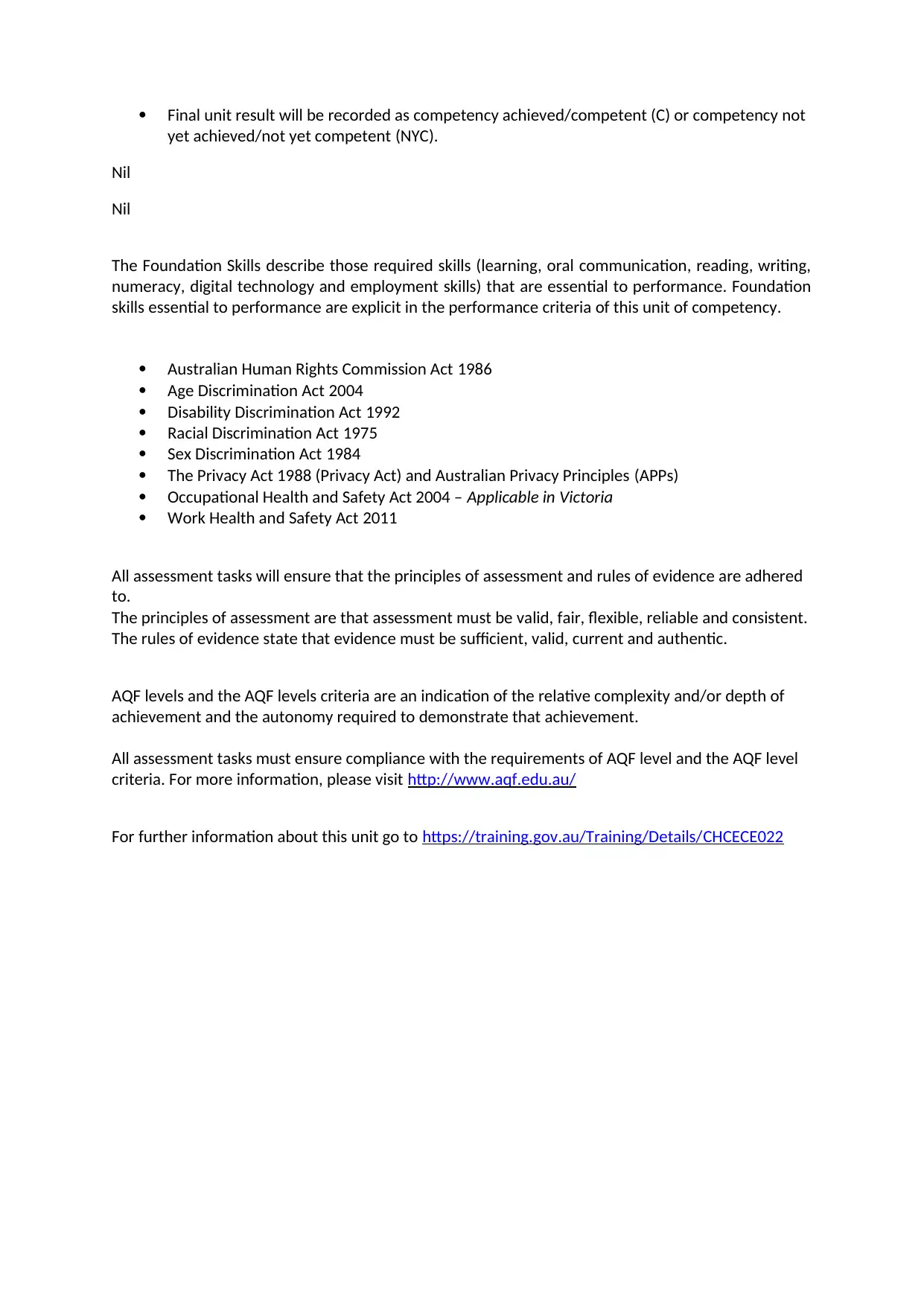
Final unit result will be recorded as competency achieved/competent (C) or competency not
yet achieved/not yet competent (NYC).
Nil
Nil
The Foundation Skills describe those required skills (learning, oral communication, reading, writing,
numeracy, digital technology and employment skills) that are essential to performance. Foundation
skills essential to performance are explicit in the performance criteria of this unit of competency.
Australian Human Rights Commission Act 1986
Age Discrimination Act 2004
Disability Discrimination Act 1992
Racial Discrimination Act 1975
Sex Discrimination Act 1984
The Privacy Act 1988 (Privacy Act) and Australian Privacy Principles (APPs)
Occupational Health and Safety Act 2004 – Applicable in Victoria
Work Health and Safety Act 2011
All assessment tasks will ensure that the principles of assessment and rules of evidence are adhered
to.
The principles of assessment are that assessment must be valid, fair, flexible, reliable and consistent.
The rules of evidence state that evidence must be sufficient, valid, current and authentic.
AQF levels and the AQF levels criteria are an indication of the relative complexity and/or depth of
achievement and the autonomy required to demonstrate that achievement.
All assessment tasks must ensure compliance with the requirements of AQF level and the AQF level
criteria. For more information, please visit http://www.aqf.edu.au/
For further information about this unit go to https://training.gov.au/Training/Details/CHCECE022
yet achieved/not yet competent (NYC).
Nil
Nil
The Foundation Skills describe those required skills (learning, oral communication, reading, writing,
numeracy, digital technology and employment skills) that are essential to performance. Foundation
skills essential to performance are explicit in the performance criteria of this unit of competency.
Australian Human Rights Commission Act 1986
Age Discrimination Act 2004
Disability Discrimination Act 1992
Racial Discrimination Act 1975
Sex Discrimination Act 1984
The Privacy Act 1988 (Privacy Act) and Australian Privacy Principles (APPs)
Occupational Health and Safety Act 2004 – Applicable in Victoria
Work Health and Safety Act 2011
All assessment tasks will ensure that the principles of assessment and rules of evidence are adhered
to.
The principles of assessment are that assessment must be valid, fair, flexible, reliable and consistent.
The rules of evidence state that evidence must be sufficient, valid, current and authentic.
AQF levels and the AQF levels criteria are an indication of the relative complexity and/or depth of
achievement and the autonomy required to demonstrate that achievement.
All assessment tasks must ensure compliance with the requirements of AQF level and the AQF level
criteria. For more information, please visit http://www.aqf.edu.au/
For further information about this unit go to https://training.gov.au/Training/Details/CHCECE022
Paraphrase This Document
Need a fresh take? Get an instant paraphrase of this document with our AI Paraphraser
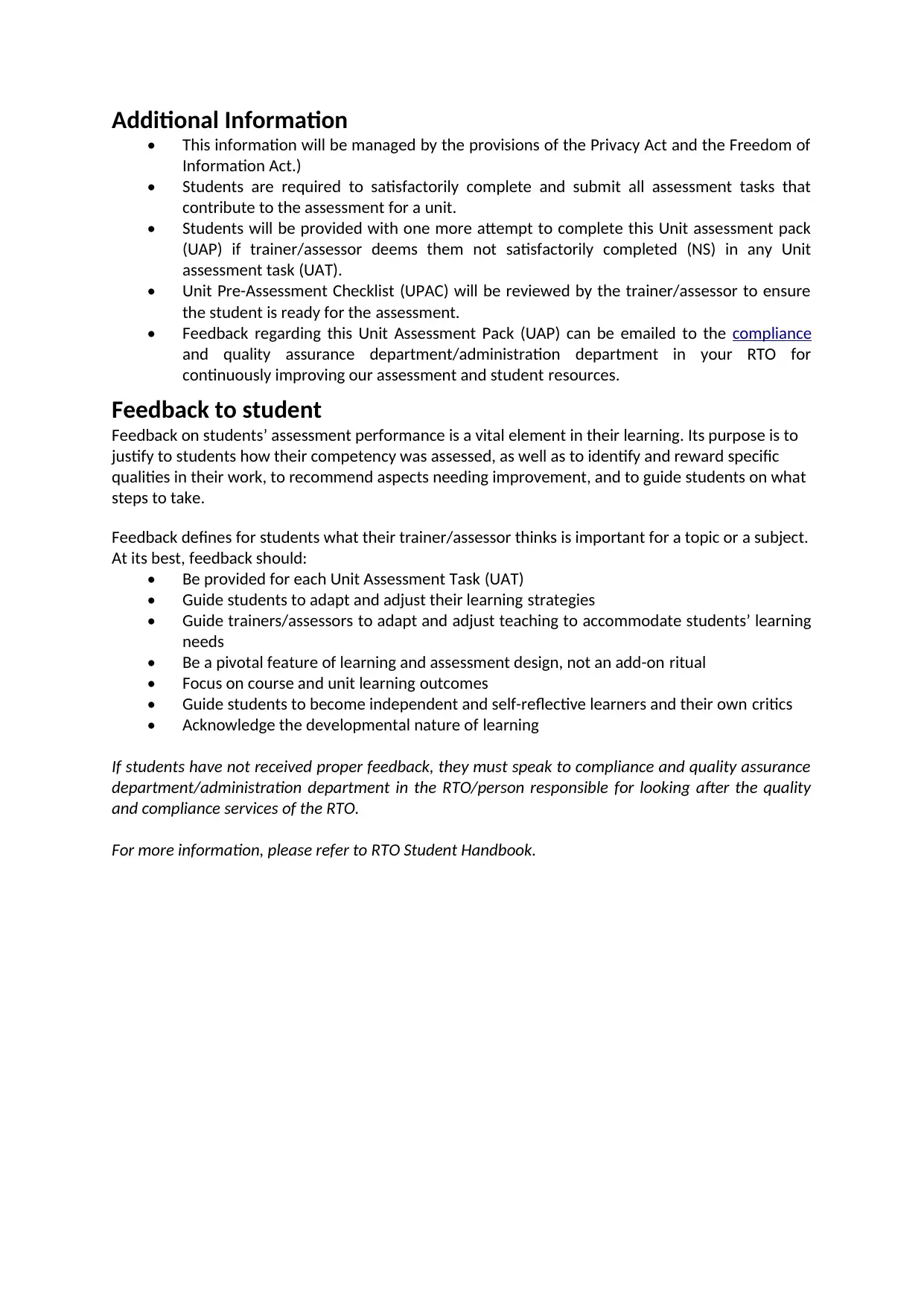
Additional Information
• This information will be managed by the provisions of the Privacy Act and the Freedom of
Information Act.)
• Students are required to satisfactorily complete and submit all assessment tasks that
contribute to the assessment for a unit.
• Students will be provided with one more attempt to complete this Unit assessment pack
(UAP) if trainer/assessor deems them not satisfactorily completed (NS) in any Unit
assessment task (UAT).
• Unit Pre-Assessment Checklist (UPAC) will be reviewed by the trainer/assessor to ensure
the student is ready for the assessment.
• Feedback regarding this Unit Assessment Pack (UAP) can be emailed to the compliance
and quality assurance department/administration department in your RTO for
continuously improving our assessment and student resources.
Feedback to student
Feedback on students’ assessment performance is a vital element in their learning. Its purpose is to
justify to students how their competency was assessed, as well as to identify and reward specific
qualities in their work, to recommend aspects needing improvement, and to guide students on what
steps to take.
Feedback defines for students what their trainer/assessor thinks is important for a topic or a subject.
At its best, feedback should:
• Be provided for each Unit Assessment Task (UAT)
• Guide students to adapt and adjust their learning strategies
• Guide trainers/assessors to adapt and adjust teaching to accommodate students’ learning
needs
• Be a pivotal feature of learning and assessment design, not an add-on ritual
• Focus on course and unit learning outcomes
• Guide students to become independent and self-reflective learners and their own critics
• Acknowledge the developmental nature of learning
If students have not received proper feedback, they must speak to compliance and quality assurance
department/administration department in the RTO/person responsible for looking after the quality
and compliance services of the RTO.
For more information, please refer to RTO Student Handbook.
• This information will be managed by the provisions of the Privacy Act and the Freedom of
Information Act.)
• Students are required to satisfactorily complete and submit all assessment tasks that
contribute to the assessment for a unit.
• Students will be provided with one more attempt to complete this Unit assessment pack
(UAP) if trainer/assessor deems them not satisfactorily completed (NS) in any Unit
assessment task (UAT).
• Unit Pre-Assessment Checklist (UPAC) will be reviewed by the trainer/assessor to ensure
the student is ready for the assessment.
• Feedback regarding this Unit Assessment Pack (UAP) can be emailed to the compliance
and quality assurance department/administration department in your RTO for
continuously improving our assessment and student resources.
Feedback to student
Feedback on students’ assessment performance is a vital element in their learning. Its purpose is to
justify to students how their competency was assessed, as well as to identify and reward specific
qualities in their work, to recommend aspects needing improvement, and to guide students on what
steps to take.
Feedback defines for students what their trainer/assessor thinks is important for a topic or a subject.
At its best, feedback should:
• Be provided for each Unit Assessment Task (UAT)
• Guide students to adapt and adjust their learning strategies
• Guide trainers/assessors to adapt and adjust teaching to accommodate students’ learning
needs
• Be a pivotal feature of learning and assessment design, not an add-on ritual
• Focus on course and unit learning outcomes
• Guide students to become independent and self-reflective learners and their own critics
• Acknowledge the developmental nature of learning
If students have not received proper feedback, they must speak to compliance and quality assurance
department/administration department in the RTO/person responsible for looking after the quality
and compliance services of the RTO.
For more information, please refer to RTO Student Handbook.
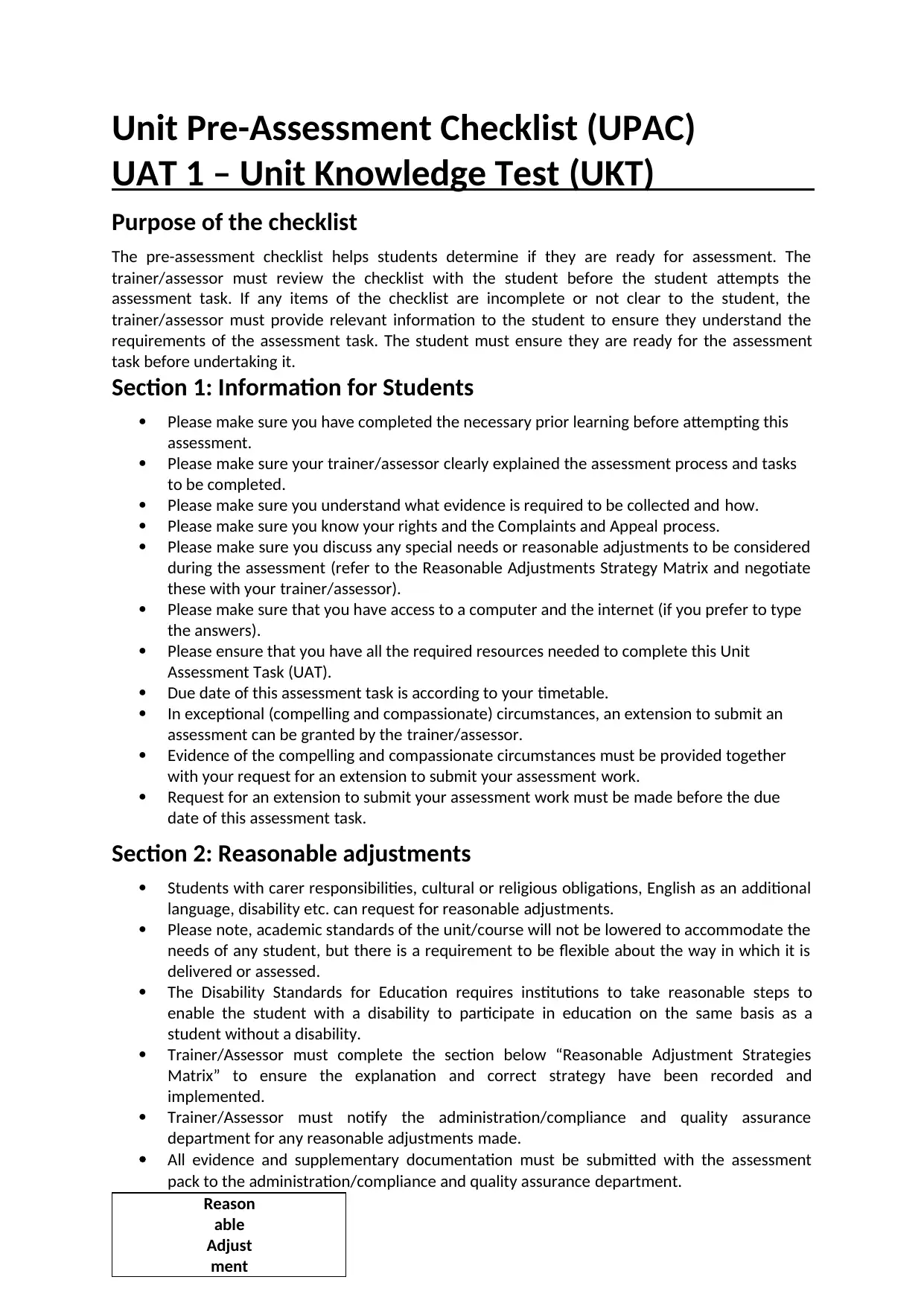
Unit Pre-Assessment Checklist (UPAC)
UAT 1 – Unit Knowledge Test (UKT)
Purpose of the checklist
The pre-assessment checklist helps students determine if they are ready for assessment. The
trainer/assessor must review the checklist with the student before the student attempts the
assessment task. If any items of the checklist are incomplete or not clear to the student, the
trainer/assessor must provide relevant information to the student to ensure they understand the
requirements of the assessment task. The student must ensure they are ready for the assessment
task before undertaking it.
Section 1: Information for Students
Please make sure you have completed the necessary prior learning before attempting this
assessment.
Please make sure your trainer/assessor clearly explained the assessment process and tasks
to be completed.
Please make sure you understand what evidence is required to be collected and how.
Please make sure you know your rights and the Complaints and Appeal process.
Please make sure you discuss any special needs or reasonable adjustments to be considered
during the assessment (refer to the Reasonable Adjustments Strategy Matrix and negotiate
these with your trainer/assessor).
Please make sure that you have access to a computer and the internet (if you prefer to type
the answers).
Please ensure that you have all the required resources needed to complete this Unit
Assessment Task (UAT).
Due date of this assessment task is according to your timetable.
In exceptional (compelling and compassionate) circumstances, an extension to submit an
assessment can be granted by the trainer/assessor.
Evidence of the compelling and compassionate circumstances must be provided together
with your request for an extension to submit your assessment work.
Request for an extension to submit your assessment work must be made before the due
date of this assessment task.
Section 2: Reasonable adjustments
Students with carer responsibilities, cultural or religious obligations, English as an additional
language, disability etc. can request for reasonable adjustments.
Please note, academic standards of the unit/course will not be lowered to accommodate the
needs of any student, but there is a requirement to be flexible about the way in which it is
delivered or assessed.
The Disability Standards for Education requires institutions to take reasonable steps to
enable the student with a disability to participate in education on the same basis as a
student without a disability.
Trainer/Assessor must complete the section below “Reasonable Adjustment Strategies
Matrix” to ensure the explanation and correct strategy have been recorded and
implemented.
Trainer/Assessor must notify the administration/compliance and quality assurance
department for any reasonable adjustments made.
All evidence and supplementary documentation must be submitted with the assessment
pack to the administration/compliance and quality assurance department.
Reason
able
Adjust
ment
UAT 1 – Unit Knowledge Test (UKT)
Purpose of the checklist
The pre-assessment checklist helps students determine if they are ready for assessment. The
trainer/assessor must review the checklist with the student before the student attempts the
assessment task. If any items of the checklist are incomplete or not clear to the student, the
trainer/assessor must provide relevant information to the student to ensure they understand the
requirements of the assessment task. The student must ensure they are ready for the assessment
task before undertaking it.
Section 1: Information for Students
Please make sure you have completed the necessary prior learning before attempting this
assessment.
Please make sure your trainer/assessor clearly explained the assessment process and tasks
to be completed.
Please make sure you understand what evidence is required to be collected and how.
Please make sure you know your rights and the Complaints and Appeal process.
Please make sure you discuss any special needs or reasonable adjustments to be considered
during the assessment (refer to the Reasonable Adjustments Strategy Matrix and negotiate
these with your trainer/assessor).
Please make sure that you have access to a computer and the internet (if you prefer to type
the answers).
Please ensure that you have all the required resources needed to complete this Unit
Assessment Task (UAT).
Due date of this assessment task is according to your timetable.
In exceptional (compelling and compassionate) circumstances, an extension to submit an
assessment can be granted by the trainer/assessor.
Evidence of the compelling and compassionate circumstances must be provided together
with your request for an extension to submit your assessment work.
Request for an extension to submit your assessment work must be made before the due
date of this assessment task.
Section 2: Reasonable adjustments
Students with carer responsibilities, cultural or religious obligations, English as an additional
language, disability etc. can request for reasonable adjustments.
Please note, academic standards of the unit/course will not be lowered to accommodate the
needs of any student, but there is a requirement to be flexible about the way in which it is
delivered or assessed.
The Disability Standards for Education requires institutions to take reasonable steps to
enable the student with a disability to participate in education on the same basis as a
student without a disability.
Trainer/Assessor must complete the section below “Reasonable Adjustment Strategies
Matrix” to ensure the explanation and correct strategy have been recorded and
implemented.
Trainer/Assessor must notify the administration/compliance and quality assurance
department for any reasonable adjustments made.
All evidence and supplementary documentation must be submitted with the assessment
pack to the administration/compliance and quality assurance department.
Reason
able
Adjust
ment
⊘ This is a preview!⊘
Do you want full access?
Subscribe today to unlock all pages.

Trusted by 1+ million students worldwide
1 out of 74
Related Documents
Your All-in-One AI-Powered Toolkit for Academic Success.
+13062052269
info@desklib.com
Available 24*7 on WhatsApp / Email
![[object Object]](/_next/static/media/star-bottom.7253800d.svg)
Unlock your academic potential
Copyright © 2020–2026 A2Z Services. All Rights Reserved. Developed and managed by ZUCOL.





